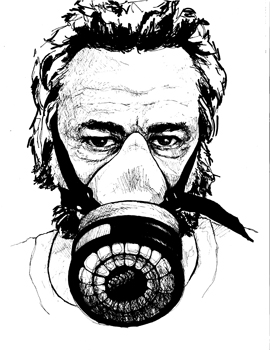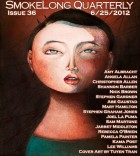Your story, “Sand and Brush and Stucco,” is full of lyric, complex language. It’s not an easy story, but brings rewards with each reading. Can you talk a little bit about how this story came about?
The spark for the piece was a photo of a friend who is wearing gold lamé pants and just killing it. That photo reminded me of an image that I made of a figure dressed in gold in a landscape. That picture accompanies the story online. So, the story was prompted by two images and the act of looking itself, which probably influenced the character—she observes but doesn’t seem to participate.
You mention acts of “looking” and participating, or rather the drying up of your character’s desire to do either. You use the desert to reflect this. She places herself in this landscape hoping to erase—hope? There is the theme of shrinking from life. At what point do you think about theme in your process?
The character in the story has become a blunt instrument over time and she knows it. It could be a victory of sorts for her to make sense of her situation and acknowledge it with some clarity.
A friend of mine gave me a book that is a dictionary of literary terms. Maybe that was a hint, but I choose not to look theme directly in the eyes when I’m working. I think of the initial stages of writing as the discovery process and I record anything that comes to mind in the order that I think of it. I deal with the circumstantial evidence that accumulates with a minimum of premeditation. Sounds like someone has been watching too many courtroom dramas.
Recently the same person who gave me the book of literary terms, the artist Cara Benedetto, told me that, “Self-editing in art is bad, material editing is good.” I have to be especially vigilant about the first part.
You say, “I choose not to look theme directly in the eyes when I’m working.” Exactly. Usually theme evolves from the sub-conscious and is shaped in the late stages of the process after the “circumstantial evidence” has accumulated. In this story, the evidence points to a woman who is a “blunt instrument;” who are some of your other characters and what effective imagery have you used for them?
One woman steals from gravel yards, materials that are behind a gate but “in full view to arouse landless people.” “The decadence of piling up land upon land reminds her of rolling around in her mother’s bed in her mother’s good jewelry.”
Two women collaborate to escape a torturous meeting, but one is always left behind to create the distraction that covers the other’s escape: “She smelled what time it was. I farted an audible and kicked at the floor with my sneaker until the sole made a squeak that was comparable in volume if not in timbre. She never looked back.”
Many of my characters try to make the best of what they have: “Someone is shooting nearby right now and East Texas sure looks junky this morning. One of the first things I saw when I returned was a church sign that said, ‘Why worry when you can pray?’ I found it helpful. I knew I wasn’t going to pray so I decided not to worry either.”
Who do you read? If you were looking for two or three stories to tell a fellow writer to read, what would those must-reads be and why?
I am catholic in my reading habits. Here is a random list of some of my favorite authors that I cut and pasted from my online dating profile: Alice Munro, Janet Malcolm, George Saunders, John Ashbery, Ariana Reines, Donald Barthelme, Lawrence Sterne, Saul Bellow, Vladimir Nabokov, Miranda July, Liam Gillick, Nathanael West, Joan Didion and Nadine Gordimer.
Sorting through my parent’s books, I recently came across “How I Contemplated the World from the Detroit House of Correction and Began My Life Over Again,” a Joyce Carol Oates story published in TriQuartery 15, Spring 1969. I know the particulars because I photocopied it for a friend and myself. It is stunning and I keep it close to remind me that I should just give it up. If anyone needs to thin his or her creative writing seminars, I recommend handing this out in the beginning.
The first Barry Hannah story I ever read was the only thing I could find of his online, it was in the New Yorker archives. It’s called “The Wretched Seventies: A Decade of Darkness Recollected in Tranquility.” It is easily under 1000 words and utterly comprehensive. I have several of his books, but I’m scared to read more. He is scary good.
gary lutz is a must-read author. His writing manifests states that I have experienced, but have never been able to articulate. I wish I could recommend a story, but you are just going to have to read every one of them, so set aside some time.
What are you working on now? What is your dream project?
I am rounding out a book of short stories. I am also experimenting with ways to integrate images, video and short fiction—my background is visual art. It may end up working like triangulation, using different media in combination to isolate something that is hard for me to put my finger on.



 The core workshop of SmokeLong Fitness is all in writing, so you can take part from anywhere at anytime. We are excited about creating a supportive, consistent and structured environment for flash writers to work on their craft in a community. We are thrilled and proud to say that our workshop participants have won, placed, or been listed in every major flash competition. Community works.
The core workshop of SmokeLong Fitness is all in writing, so you can take part from anywhere at anytime. We are excited about creating a supportive, consistent and structured environment for flash writers to work on their craft in a community. We are thrilled and proud to say that our workshop participants have won, placed, or been listed in every major flash competition. Community works.